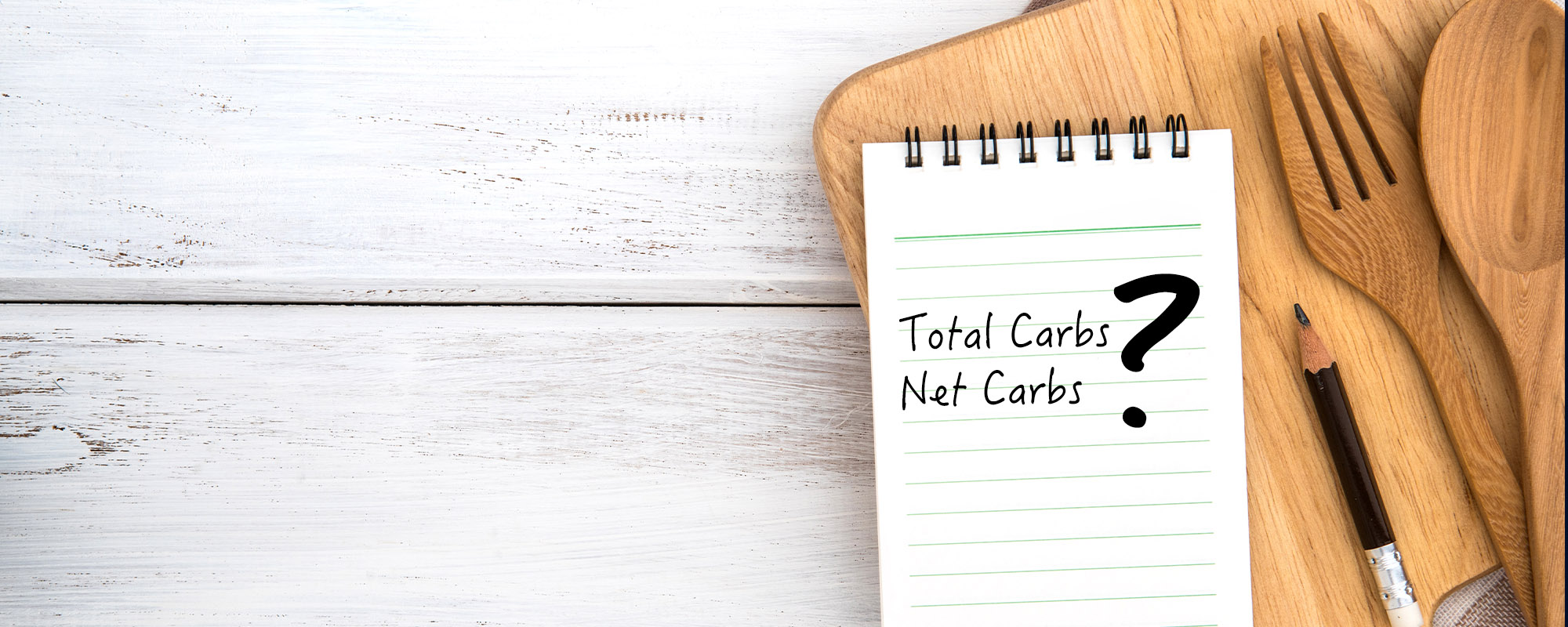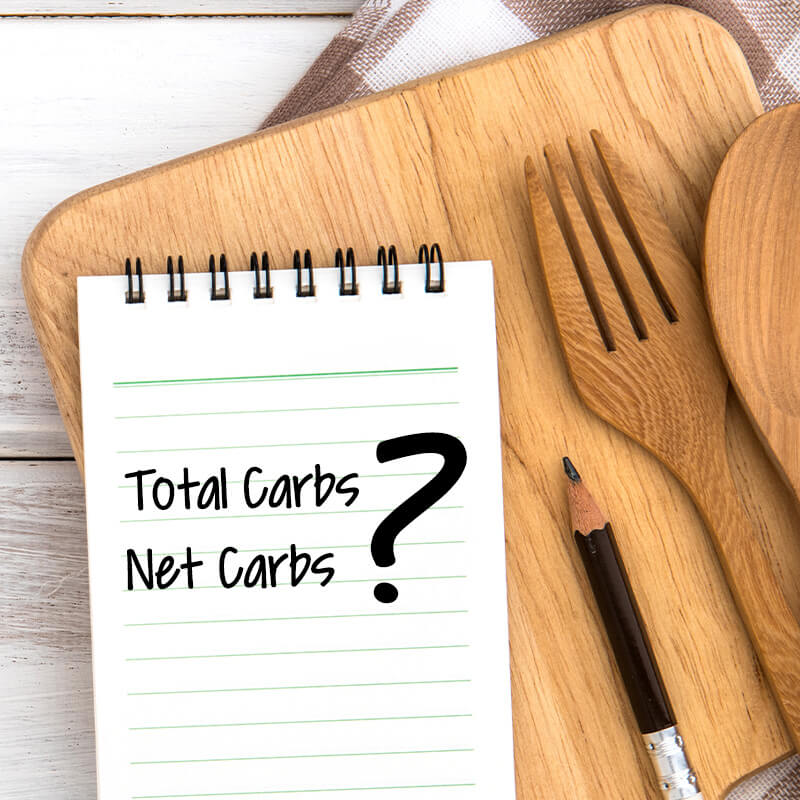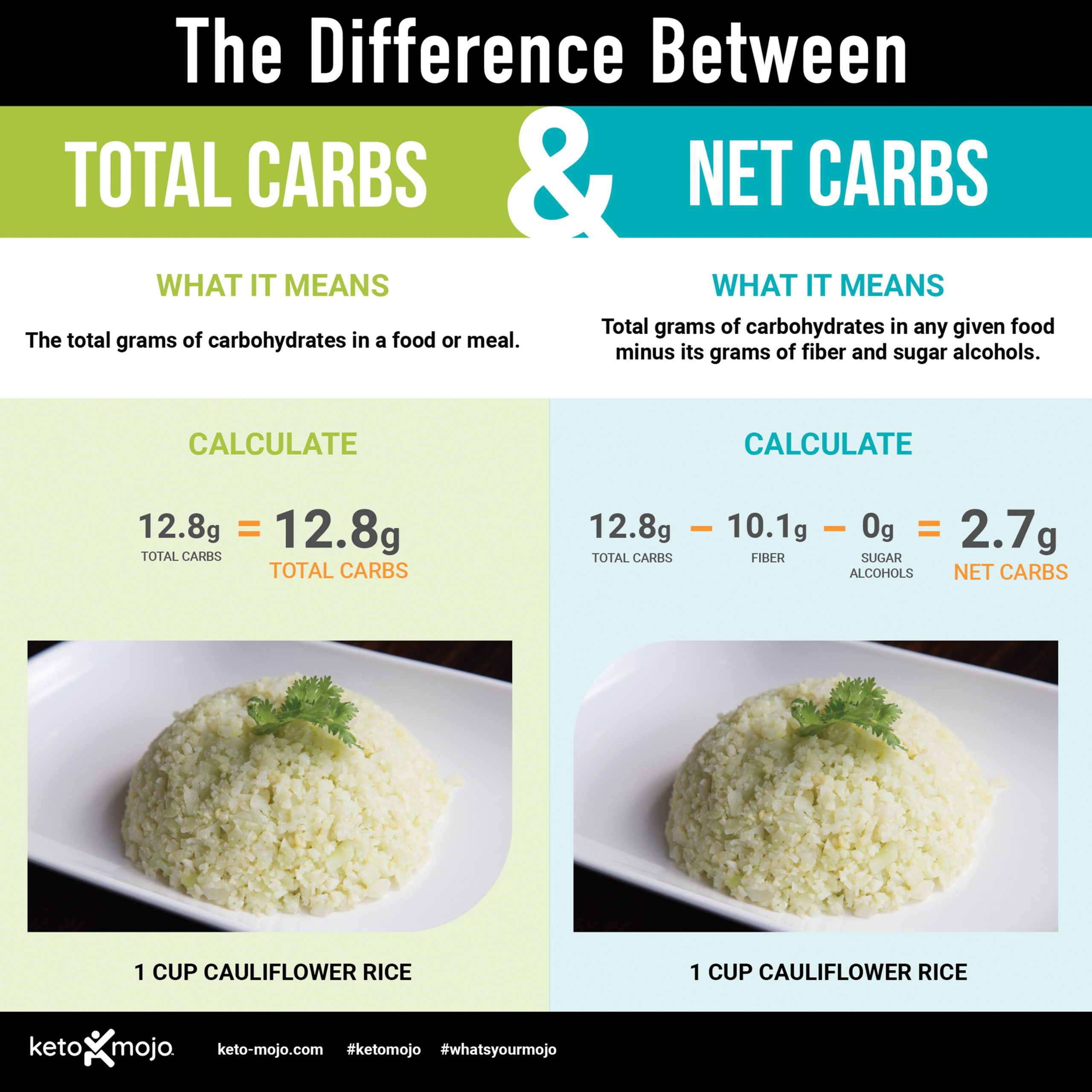The minute you begin exploring the keto diet, you’ll learn that in order to follow it successfully, you need to significantly restrict your carbohydrate intake. But by how much? Some sources say you should limit your intake to 20 grams of total carbs per day, while others say 20 grams of net carbs per day. What’s the difference between total carbs and net carbs, and why does it matter? We’ll explain everything you need to know here so you can decide the daily carb intake that’s right for you.
What’s the Purpose of Limiting Carbs?
To understand why you need to know about net and total carbs, it’s good to have a solid understanding of the role carb limitation plays in the keto diet.
The entire goal of a ketogenic diet is to get and keep your body in a state of ketosis. This is where the body relies on fat for energy rather than carbs (sugar), and your ketone levels are at least 0.5 mmol/L when you test them (In addition, your blood glucose decreases significantly, as sugar/carbs are known to raise blood glucose).
The only way to achieve ketosis is to drastically restrict your carb intake so that your body begins producing ketones from stored and consumed fats and uses them for energy. Once you’re in ketosis, the goal is to stay there and optimize its many benefits. The only way to do this is to continue to limit your carb intake.
But by how much, exactly?
How Many Carbs Should You Eat per Day on a Keto Diet?
Fortunately, the amount of carbs you should eat on a keto diet is not arbitrary. In fact, it’s scientific, though there is some confusion due to nuances we’ll explain here.
Total Carbs
Counting “total carbs” is exactly what it sounds like: you count the total grams of carbs in food consumed in one day. The grams of fiber and sugar alcohols are not subtracted from this amount.
Net Carbs
Rather than counting total carbs, there is a consensus among experts that most people can stay solidly in ketosis (i.e., maintain ketone levels of at least 0.5 mmol/L or more), if they consume 20 or fewer grams of net carbs per day.
Here’s where it can get confusing for keto newcomers: “Net carbs” are not the same as “total carbs.”
Net carbs are the total grams of carbohydrates in any given food minus its grams of dietary fiber and certain sugar alcohols.
Dietary fiber is the portion of carbohydrate in plant foods that isn’t broken down and absorbed by your digestive tract.Instead, fiber passes through your system until it reaches your colon, where it is either fermented by bacteria into short-chain fatty acids or eliminated in feces, depending on the type.
Most sugar alcohols are partially digested and absorbed into the digestive tract, and for this reason they may raise blood glucose and lower ketone levels. However, erythritol has a minimal impact on blood glucose and ketone levels because most of it passes into the urine without being metabolized. (Mannitol is another sugar alcohol that does not affect blood glucose and insulin levels, but it rarely used because it isn’t very sweet and has a very strong laxative effect.)
The basic formula for Counting Net Carbs:
Net carbohydrates = total carbohydrates – fiber – erythritol (if applicable).
When we say “fiber” we mean both insoluble fiber and soluble fiber.
If you’re not familiar with sugar alcohols, you can learn about them here.
Here’s an example of the net carb calculation, using 1 cup of cauliflower rice:
1 cup of cauliflower rice contains 4.8 grams of total carbs and 3.2 grams of fiber. To get its net carbs, you subtract the fiber (3.2 grams) from the total carbs (4.8 grams), which leaves you with 1.6 grams of net carbs:
4.8 grams carbs – 3.2 grams fiber = 1.6 grams net carbs in 1 cup of cauliflower rice.
Counting net carbs rather than total carbs is easier to do, allows you far greater consumption of vegetables and other wholesome foods that contain carbohydrates, and, as we mentioned, still allows you to stay in ketosis.
When calculating net carbs, it’s a good idea to only subtract the fiber that naturally occurs in whole food, because your body may respond differently to some forms of “added fiber” in keto and low-carb products. We recommend that you test your blood glucose and ketones after consuming products with added fiber to see how they affect you.
Now let’s try an example of calculating net carbs with a food that contains sugar alcohols.
There are many keto and low-carb products that utilize sugar-alcohol-based sweeteners to sweeten food products, and there are also recipes that call for sugar alcohols. While there are many out there (maltitol, xylitol, sorbitol, etc.), we recommend erythritol as a sweetener because, as we mentioned above, it doesn’t tend to affect blood sugar or ketone levels.
So, for this example, we’ll go with homemade keto whipped cream (2 cups of heavy whipping cream and 2 teaspoons of erythritol, whipped together – enough for 16 servings).
Here, the whipping cream contains 32 grams of carbohydrates and 0 grams of dietary, while the erythritol contains 8 grams of total carbs and 8 grams of sugar alcohol, which can be subtracted. So, the net carbs count is 32 – 0 + 8 – 8 = 32 net carbs total for enough whipped cream to serve 16 people (thus, 2 net carbs per serving).
What about allulose, the popular sweetener that is increasingly being used as in food products? Allulose isn’t a sugar alcohol; it’s a “rare” sugar that your body can’t metabolize and absorb. Therefore, the carbs from allulose can be subtracted from the total carb count. Some food manufacturers do this calculation for the nutrition facts label, while others do not.
Testing for Your Carb Edge or Bio-Individuality
Once you’re solidly in ketosis for three or more months, some people like to test their “carb edge,” to determine whether they can consume more than 20 grams of net carbs per day and still stay in ketosis. You can do this by gradually increasing your daily carbohydrate consumption and testing your glucose and ketones daily to see if you get glucose spikes or get kicked out of ketosis by eating more carb foods, including carb-heavy veggies. Learn more about testing for your carb edge here.
It’s also a good idea to test yourself for bio-individuality, or how your unique body responds to certain keto-friendly foods or processed foods. Some people get a glucose spike with certain sugar alcohols or dairy, for example. Testing your glucose and ketones before and after eating questionable foods allows you to discover if a food sensitivity is impeding your ability to stay in ketosis and achieve keto success.
To help you keep track of all your testing and subsequent results, Keto-Mojo offers a free app where you can sync your readings to your smartphone and then tag or make notes in your readings. That means you can either tag or make notes on the foods you ate before testing or how many net carbs you’ve had for the day. You can even filter your readings by tags. To get even more insight into your readings with graphs and trends, or integrations with other health apps like Cronometer or Carb Manager, you can sign up for a MyMojoHealth account within the app. Learn more here.
The Final Word on the Difference Between Total Carbs vs Net Carbs
Total carbs are exactly that —the sum of all the carbs you eat in a day. Net carbs are calculated by taking your total carbs and subtracting fiber and certain sugar alcohols.
When calculating net carbs, you can subtract the carbs that come from dietary fiber that’s naturally found in whole foods like vegetables, nuts, and seeds. You can also subtract the carbs from erythritol, when it’s used in modest amounts. For added fiber and other sugar alcohols, test your blood glucose and ketone levels to see how your body responds to them.
For optimal results, eat mostly whole foods, avoid foods with added sugar, and read the nutrition facts panel and ingredients list on packaged foods.
Disclaimer: It’s always a good idea to consult with a dietitian and your primary care provider before starting any new diet.





